Rise of Tribes
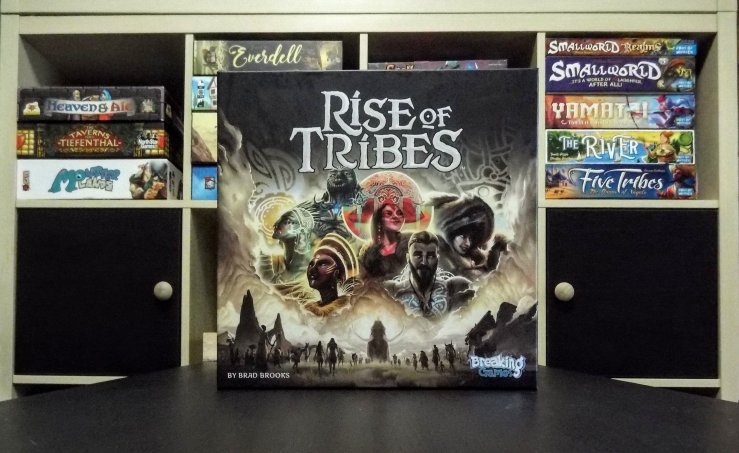
- Designer: Brad Brooks
- Publisher: Breaking Games
- Players: 2-4
- Age: 10+ (My 5 year old was able to play on a team and understand the basic concepts of this game.)
- Time to play: 30-60 Minutes
Hey folks! Back again with another review. This time we’re going way back. How far back? Back to the days of Sabre tooth Tigers and Woolly Mammoths. We’re trying to expand out tribes and build villages. We’re looking at Rise of Tribes. The first player to earn 15 points is the winner. So let’s don our best caveman outfit and see what we can do!
Components

- 96 Resource Tokens
- 80 Tribe Meeples
- 60 Goal Cards
- 16 Event Tiles
- 15 Basic Hex Tiles
- 14 Custom Dice
- 12 Village Tokens
- 11 Event Tokens
- 8 Scenario Hex Tiles
- 8 Player Leader Boards
- 8 Leader Cards
- 4 Tribal Elder Meeples
- 4 Arrowhead Score Markers
- 1 Volcano Hex Tile
- 1 Action Board
- 1 Resource Multiplier Token
Set Up
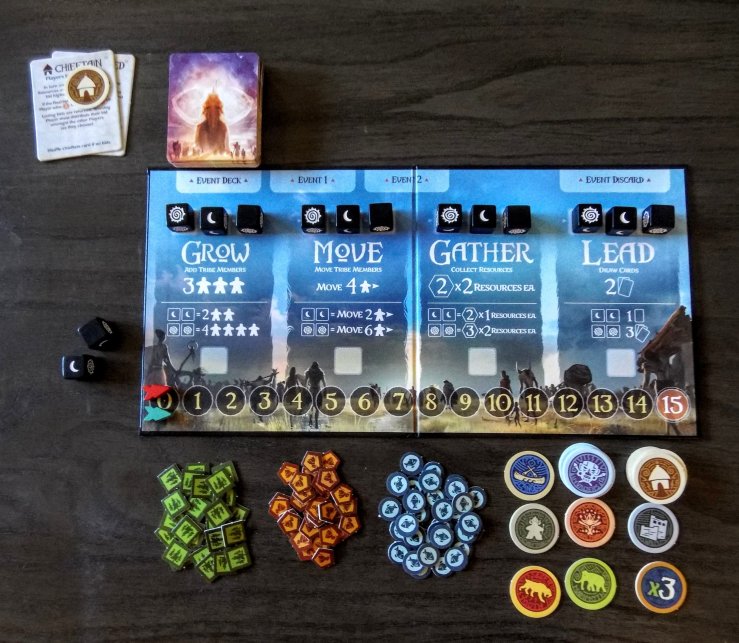

- Take a number of Lake, Forest, and Mountain Tiles equal to the number of players plus one. So in a two player game, you’ll have 3 of each type.
- Find the Volcano tile and set it aside.
- Shuffle and lay out tiles based on the pattern per player count.
- Place the action board within reach of all players.
- Place Resource Tokens and village tokens near the map.
- Look at the event tiles. Pull out the Chieftain and Abandoned Village cards.
- Shuffle the rest and place them face down above the action board.
- Players pick a color and take the meeples, arrowhead score marker, and deck of 15 goal cards in that color.
- Pick a tribe player board to play. If this is your first game, it’s suggested to use the order of play side for the first game.
- Place the players score markers on the 0 space.
- Place three dice on each of the action spots.
- The dice need to be set up as Sun, Moon, Blank for each one. Two dice should be left over. Place these next to the action board.
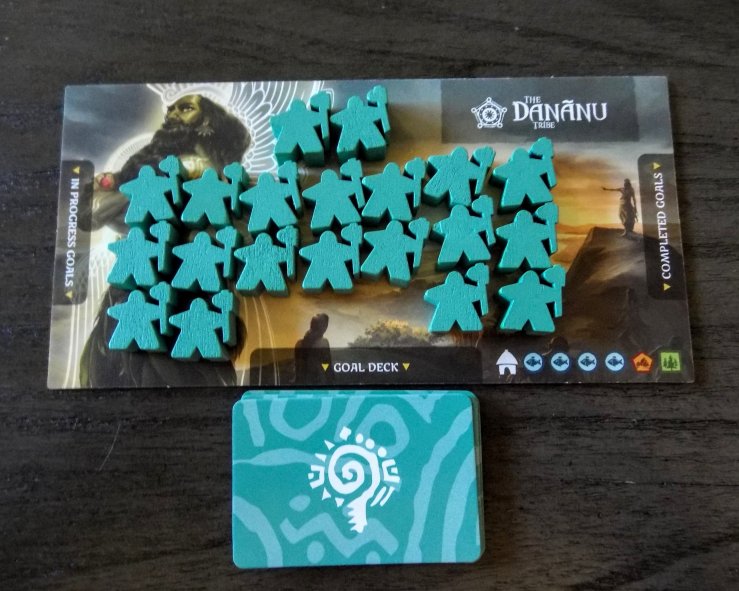
Starting player places two of their meeples on any single hex, followed by the other players. Second player gets to place three of their meeples in one hex, third player gets to place three of their meeples and collect two resources, fourth player gets to place three of their meeples in two adjacent hexes and collect two resources.
Game Play
The game is played until one player scores 15 points. Each turn a player completes these 5 steps.
1 Score Villages
The beginning of each turn, players score 1 point per every village they have.
2 Roll Two Dice
- Active player rolls the dice. If doubles are rolled, an event is triggered.
- When a player rolls doubles, they trigger an event.
- First, resolve any effects at the bottom of any active event.
- If there is an open spot for a new event, draw the event from the top of the deck and follow the instructions.
- When an event is completely resolved, remove it from the active even spot and place it in a discard pile.
3 Take Actions
The active player takes two actions by picking one action for each die rolled.
- The two actions must be different each turn.
- Slid the last die in the roll down under the action text. Slide the rest of the dice over and add the new die at the beginning of the line.
- When taking actions, the icons of the dice are looked at to determine the outcome.
- Double Suns – Better outcome than usual.
- Double Moons – Worse outcome than usual.
- Anything else – Normal outcome.
- Locations you’re taking actions are as follows.
- Grow – Add the number of tribe numbers indicated on the board to existing tribes of your color.
- Move – Move up to the number of tribe members indicated on the board from one hex to an adjacent hex.
- A single tribe member can be moved multiple hexes in a turn.
- Tribes can occupy opponents space.
- Gather – Gather resources from hexes you occupy indicated on the board.
- Forest for wood, mountains for stone, and lakes for food or fish.
- Lead – Draw cards from your goal cards as indicated on the board.
- Put these face up to the left of your tribe board. These are in progress.
- Blue cards are development cards.
- Brown cards are achievements.
- If you own villages, you may discard any unfulfilled goal card to the bottom of your goal deck and draw cards equal to that in addition to the amount for the action.
4 Resolve Conflict
The population of each hex is 5 meeples. If there is every more than 5 meeples, conflict arises.
- Conflict Resolution
- Multiple Tribes
- Active player is offensive tribe other players are defensive.
- For all tribes on the hex, players are to remove 1 of their own meeple at the same time. This is repeated until there is only one tribe on the hex.
- Development Goal Cards and Conflict – The Bow allows the offensive player to remove one opponent tribe meeple before resolving conflict.
- Villages – If after the conflict resolves and the player who owns the village has no more tribe there, the village is removed.
- Single Tribe
- Remove meeples until you get to 5 meeples.
- Multiple Tribes
5 Build Villages and Complete Goals
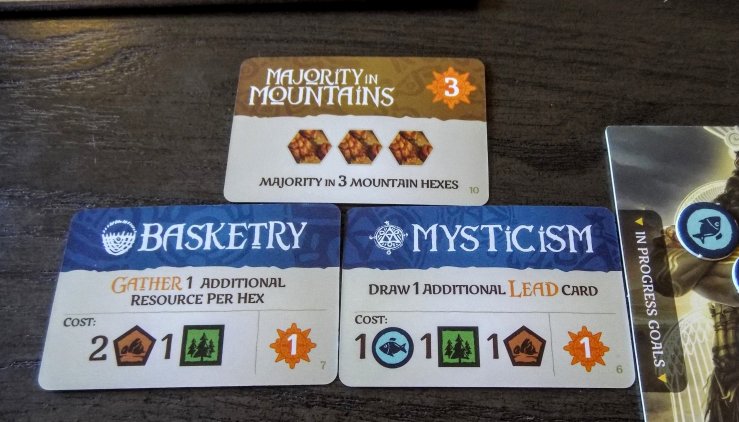
- Goal Cards
- Developments cost resources. Spend the resources on the card to move the goal card to the right side of your tribe board. Gain points as indicated on the goal card.
- Achievements are triggered by circumstances. Once an achievement has met it’s trigger, move it to the right side of the tribe board and gain those points.
At the end of the turn, a player may build any number of villages by spending the resources indicated on their tribe board. Place the village token on a hex that has your tribe on and no other village token.
- When the first village is built, shuffle the chieftain and abandoned village event tile into the event tiles.
The game ends when a player reaches 15 points. They are the winner.
There is no player elimination in the game. If a player loses their last tribe meeple, the next turn they place two of their tribes on an unoccupied hex if able.
Advanced Play
Elders
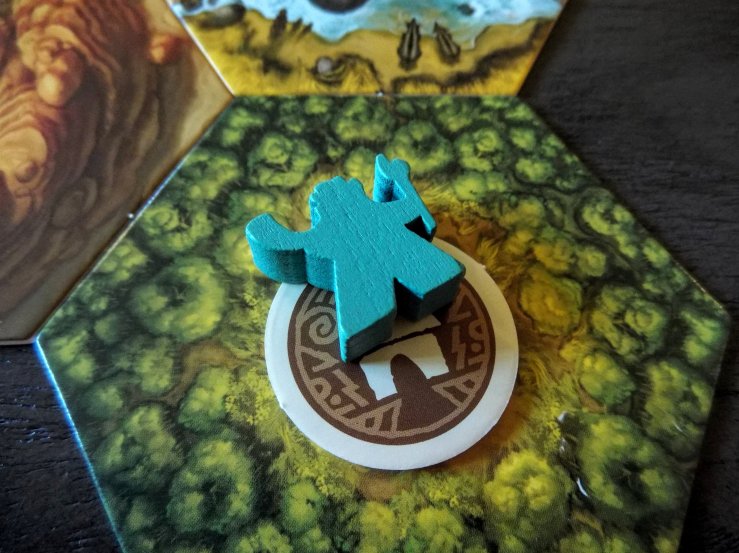
- When you build a village, you can place your elder meeple there.
- Once per turn, you can give a resource to a player and then use the ability of any single development which that player has completed.
- If the village containing the elder is destroyed, the attacking player gains one point and the elder is removed.
Special Terrain Hexes
Great Lake, Mountain, and Forests
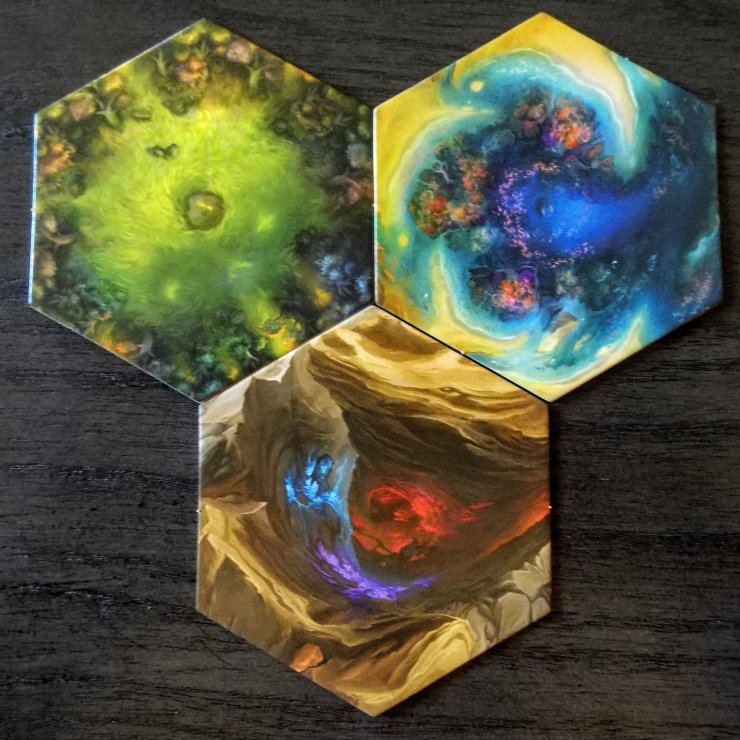
These produce an extra resource when using gather action.
Wild Land
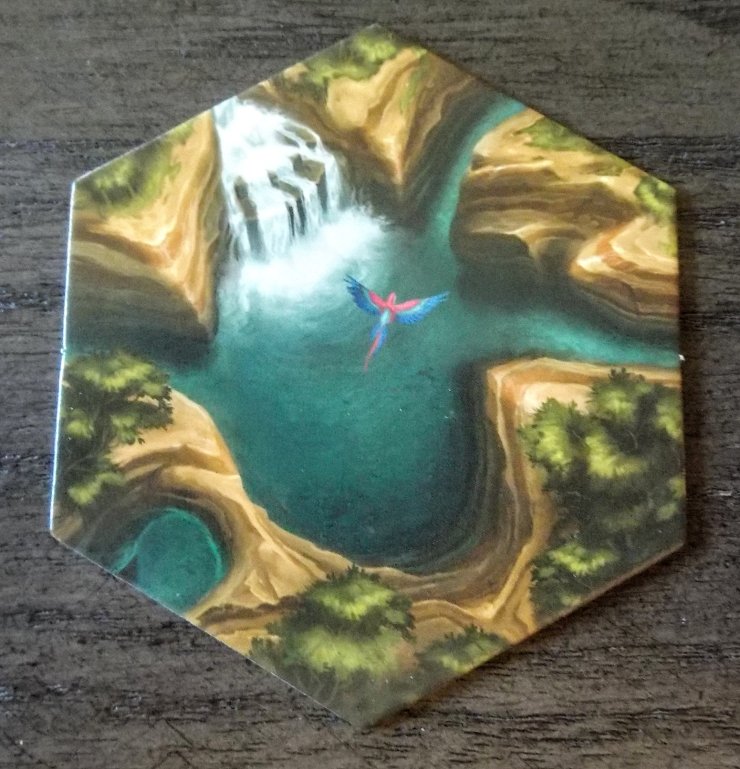
This land counts as all types when gathering for a resource. You can gather any mix of resources.
Jungle (Forest) and Oasis (Lake)
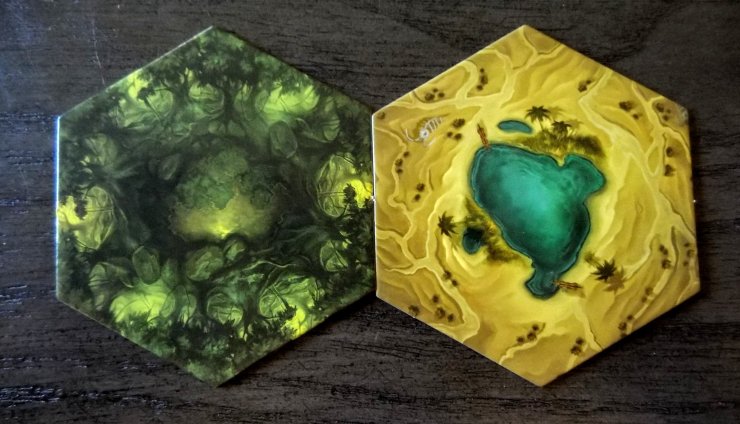
You need three tribe members here before you can gather resources.
Tar Pit

If there is ever only one member on this hex, it is lost to the tar after the conflict step.
Glacier
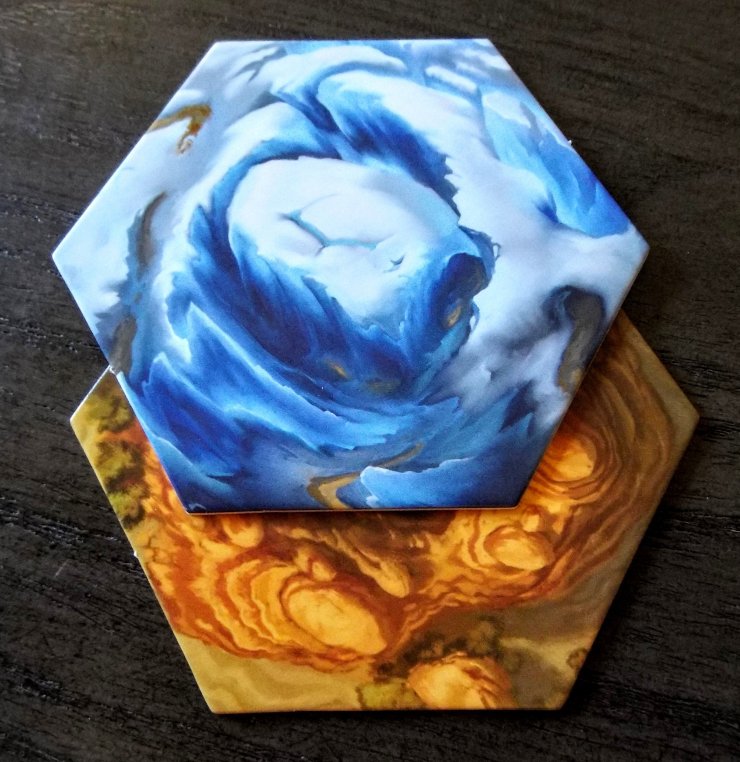
The starting player places the glacier over top of a mount tile.
There is a limit of 3 meeples and no villages on the glacier. In addition to that, there can ever only be a max of one resource gathered from here a turn.
When a player takes a double sun action, place a stone on the glacier. When the glacier receives the 5th stone, the glacier melts and it acts like a normal mountain. In addition to that, the next player to gather here receive those 5 stones.
Leader Powers

Once you’ve played the game enough times to get familiar with it, when you pick a tribe board flip it over. Take the corresponding tribe name card and pick one of the two unique powers to use for the game.
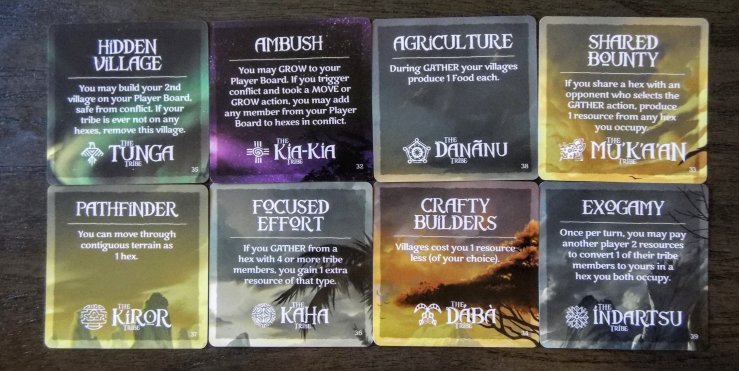

Final Thoughts
Let’s talk about the components. The game I have is the retail version of the game. The player tribe boards are nice thick cardboard. The goal cards are nice and easy to read. The meeples are fantastic! I like that each player gets a different looking meeple. The one thing I thought was a little weird was the yellow meeple. I mean, you’re hanging out with three other tribes. One with a spear, one with a hammer or club, and one with a bow. Yellow meeple chooses a vase? Maybe it’s filled with bees for when they conflict with the other tribes. The resources are a bit small for my liking. The villages and other tokens are a good size. The dice are nice custom dice, and the symbols are easy to read.

Now, there is a bonus if you really like this game and want to upgrade it. Breaking Games makes a deluxe version of the game and a upgrade kit if you have the retail version. It includes wooden bits for the resources, saber-tooth, and mammoth. So those little resources that I’m not too fond of are now chunky bits. Now, it’s a $25 upgrade so it will really depend on your comfort level of spending extra on a game to only change the components. If you enjoy this game, I can see this as a good option.
Game play wise, I like that the layout of the map changes from game to game and from player count to player count. It adds some replay ability to the game. Then I how players choose their actions. I like that the dice rolling, and the randomness of it, can be mitigated by your options of where to place them. Then the dice you’re rolling is as important as the dice that’s on the board. I like that you’re sliding the dice over for taking an action, then the last die in the line is moved down and used for the next players roll.
The events that happen through the game is a nice touch. It breaks up the game play just a bit, and forces players to adapt their strategies. Some of the events are good and can score you bonus points. Some aren’t so good, and can change parts of the game until they are removed.
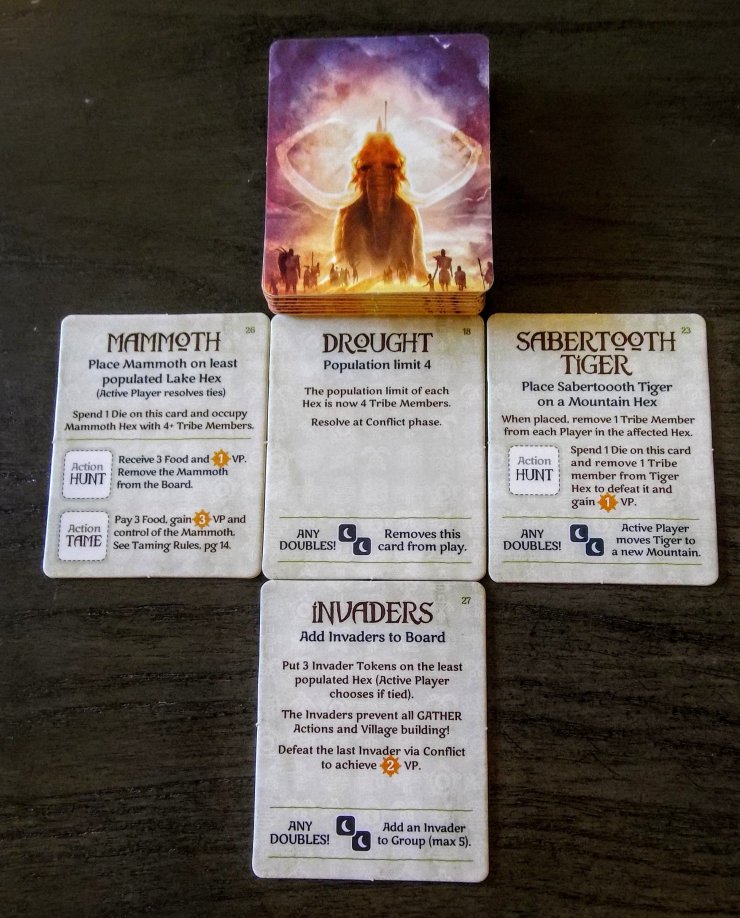
I like that this game is about managing resources and has area majority. It really feels like you’re expanding your tribe and discovering new things by growing your tribe in size, moving around the board, gathering resources, and fighting other tribes for their land. Then building and defending villages or building your goal cards.
Lastly, I like that there is a clear cut way to win. It’s the first player to 15 points. No extra turns and not the player with the highest points. It’s the player to first reach 15 points. So not only are you trying to build a good gathering tribe, you’re also racing to 15 points first. That’s where conflict comes in nicely. If another player has a village and is getting those extra points at the start of your turn, you want nothing more than to stop that. Move your tribe to that area, then grow them there. Just make sure you have equal or more tribe members, and their point making village is as good as gone.

Rise of Tribes is a beautiful and easy to play game. It’s fast to teach, fast to play, and doesn’t out stay it’s welcome on the table. In addition to being a good candidate for a gateway game, there are other things you can add to the game to make it feel a bit more advanced. This includes the special tiles, elders, and variable player powers. While it’s not going to change this from a gateway game to heavy Euro game, it will add enough intrigue to keep the advanced gamer contempt with playing a lighter game.









